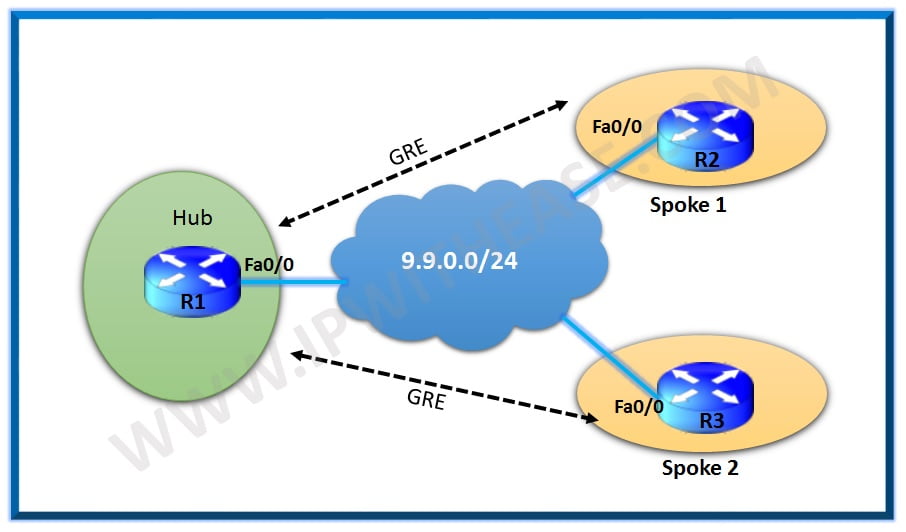In this post we will use a simple topology and configure Native Multicast step by step and verify the results as well.
–
STEP 1:
Enable ‘ip multicast-routing’ on all routers in global mode.
–
STEP 2:
Enable IGP on all the routers an in our case we have enable OSPF process 1 on all routers and area is 0.
–
STEP 3:
Next we enable ‘ip pim sparse –mode’ on all interfaces of each router.
–
STEP 4:
Now we configure IGMP on R5’s loopback interface to act as receiver.
ip pim sparse-mode
ip igmp join-group 239.192.1.1
ip ospf 1 area 0
We can verify it as well on R5 as below that it has joined the group 239.192.1.1 as below:
R5#sh ip igmp groups
239.192.1.1 Loopback0 00:14:43 00:02:31 9.9.0.5
224.0.1.40 Loopback0 00:14:39 00:02:25 9.9.0.5
We see router has also joined group 224.0.1.40 which is a default multicast group that each router joins to listen to RP discovery messages advertised by mapping agent.Mapping agent on other hand receives the announcement for RP-candidates on group address 224.0.1.39.
STEP 5:
Configure the RP as below using Cisco Proprietary Auto-RP which enables the RP to be discovered dynamically.
(Config)# ip pim send-rp-discovery Loopback0 scope 32 >>>>>>>Configures the router to be an RP mapping agent.>
As soon as Router R5 joins group 239.192.1.1 it sends IGMPV2 join message.
Dec 23 01:54:28.923: IGMP(0): Received v2 Report on Loopback0 from 9.9.0.5 for 239.192.1.1
This JOIN message is then forwarded towards the RP by each router and a (*,G) entry gets created on each router.
R1#sh ip mroute
Flags: D – Dense, S – Sparse, B – Bidir Group, s – SSM Group, C – Connected,
L – Local, P – Pruned, R – RP-bit set, F – Register flag,
T – SPT-bit set, J – Join SPT, M – MSDP created entry, E – Extranet,
X – Proxy Join Timer Running, A – Candidate for MSDP Advertisement,
U – URD, I – Received Source Specific Host Report,
Z – Multicast Tunnel, z – MDT-data group sender,
Y – Joined MDT-data group, y – Sending to MDT-data group,
G – Received BGP C-Mroute, g – Sent BGP C-Mroute,
Q – Received BGP S-A Route, q – Sent BGP S-A Route,
V – RD & Vector, v – Vector
Outgoing interface flags: H – Hardware switched, A – Assert winner
Timers: Uptime/Expires
Interface state: Interface, Next-Hop or VCD, State/Mode
(*, 239.192.1.1), 00:00:36/00:03:19, RP 9.9.0.3, flags: S
Incoming interface: FastEthernet0/0, RPF nbr 9.9.12.2
Outgoing interface list:
FastEthernet1/1, Forward/Sparse, 00:00:36/00:03:19
Same entry is seen to be created on R2 as well:
R2#sh ip mroute
IP Multicast Routing Table
Flags: D – Dense, S – Sparse, B – Bidir Group, s – SSM Group, C – Connected,
L – Local, P – Pruned, R – RP-bit set, F – Register flag,
T – SPT-bit set, J – Join SPT, M – MSDP created entry, E – Extranet,
X – Proxy Join Timer Running, A – Candidate for MSDP Advertisement,
U – URD, I – Received Source Specific Host Report,
Z – Multicast Tunnel, z – MDT-data group sender,
Y – Joined MDT-data group, y – Sending to MDT-data group,
G – Received BGP C-Mroute, g – Sent BGP C-Mroute,
Q – Received BGP S-A Route, q – Sent BGP S-A Route,
V – RD & Vector, v – Vector
Outgoing interface flags: H – Hardware switched, A – Assert winner
Timers: Uptime/Expires
Interface state: Interface, Next-Hop or VCD, State/Mode
(*, 239.192.1.1), 00:01:08/00:03:20, RP 9.9.0.3, flags: S
Incoming interface: FastEthernet1/0, RPF nbr 9.9.23.3
Outgoing interface list:
FastEthernet0/0, Forward/Sparse, 00:01:08/00:03:20
(*, 239.192.1.1), 00:04:00/00:02:37, RP 9.9.0.3, flags: S
Incoming interface: Null, RPF nbr 0.0.0.0
Outgoing interface list:
FastEthernet0/0, Forward/Sparse, 00:02:49/00:02:37
Important to note in R3’s output is that we have Incoming interface as Null as for (*,G) entry incoming interface always leads towards the RP.Contrary outgoing interface leads towards the receiver.
STEP 6:
Enable command ‘ip pim autorp listener’ on routers except RP to enable them to dynamically learn about RP.
The “ip pim autorp listener’ allows the Group 224.0.0.39 & 224.0.0.40 to be densed flooded
VERIFICATION:
Now we will try to ping from R6 to group address 239.192.1.1 and we get a reply means the multicast is working
R6#ping 239.192.1.1
Type escape sequence to abort.
Sending 1, 100-byte ICMP Echos to 239.192.1.1, timeout is 2 seconds:
Reply to request 0 from 9.9.0.5, 1308 ms
Reply to request 0 from 9.9.0.5, 1360 ms
Incoming interface: FastEthernet1/0, RPF nbr 9.9.34.3
Outgoing interface list:
FastEthernet0/0, Forward/Sparse, 00:00:03/00:03:26
Incoming interface: FastEthernet1/0, RPF nbr 9.9.23.3
Outgoing interface list:
FastEthernet0/0, Forward/Sparse, 00:00:43/00:03:18
R1:
Incoming interface: FastEthernet0/0, RPF nbr 9.9.12.2
Outgoing interface list:
FastEthernet1/1, Forward/Sparse, 00:00:59/00:03:29
Incoming interface: FastEthernet0/0, RPF nbr 9.9.15.1
Outgoing interface list:
Loopback0, Forward/Sparse, 00:01:13/00:02:36
ABOUT THE AUTHOR

You can learn more about her on her linkedin profile – Rashmi Bhardwaj




